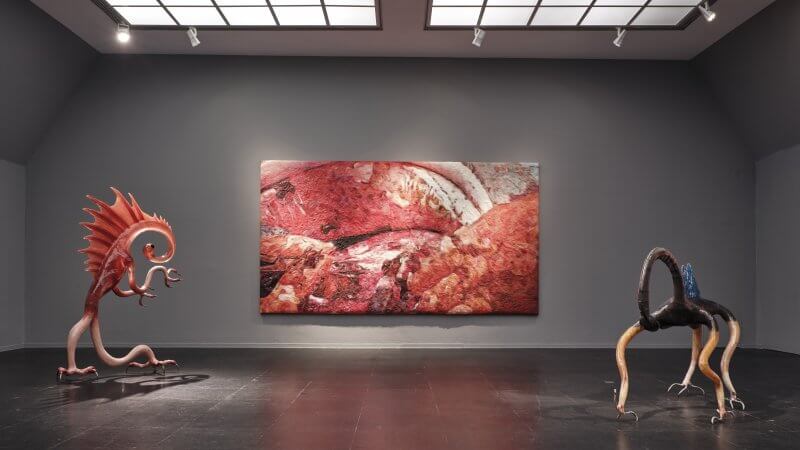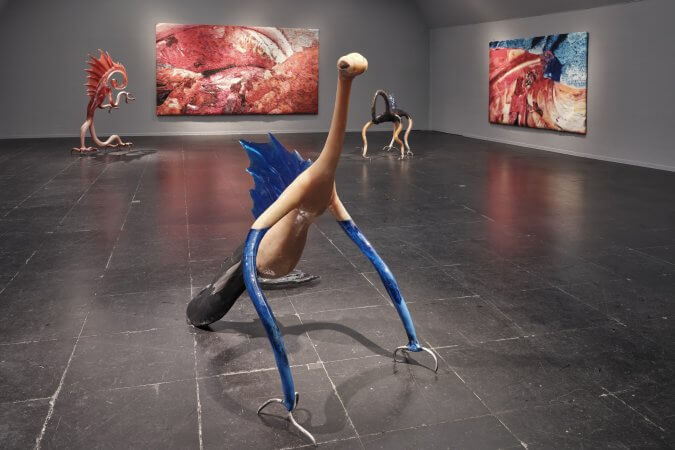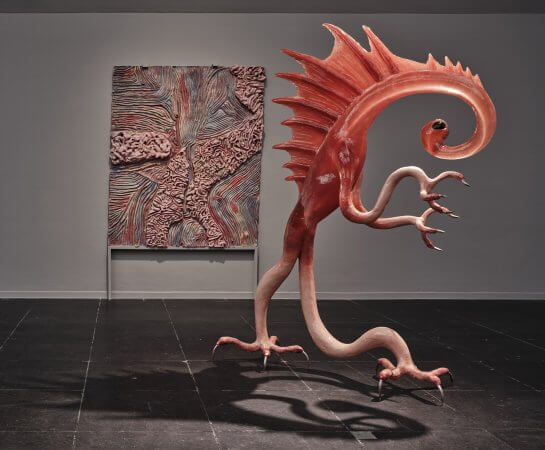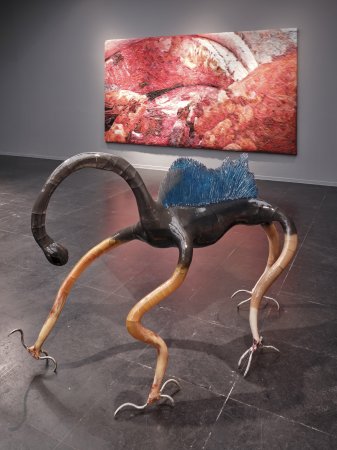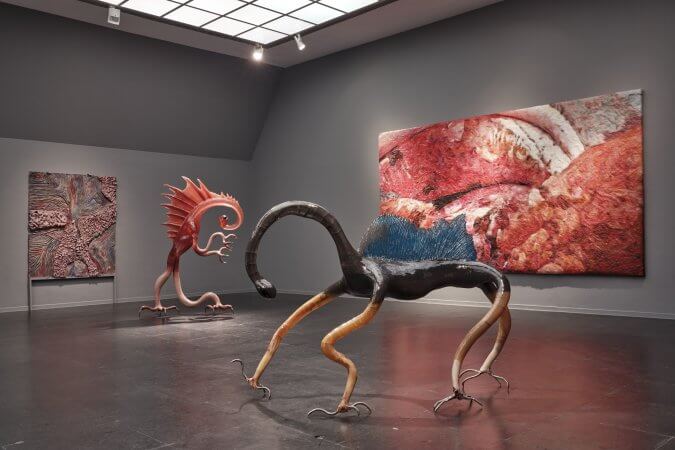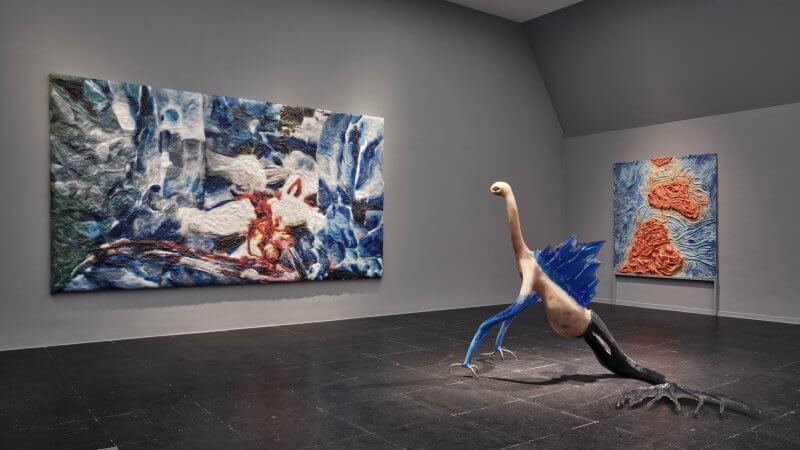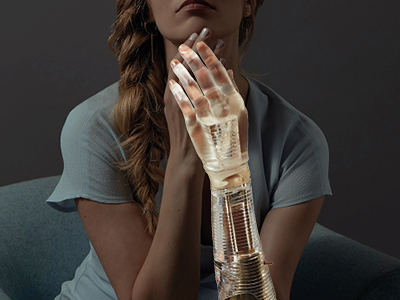Agnes Questionmark
Incertae sedis I (Birth at Sea), 2025
Resin, clear resin and iron
135 x 202 x 90 cm
Incertae sedis II (Turn Male to Mate), 2025
Resin, clear resin and iron
162 x 135 x 242 cm
Incertea sedis III (Female Adulthood), 2025
Resin, clear resin and iron
215 x 158 x 76 cm
Multivisceral abdominal resection with BiClamp®️ knife 220, 2025
Silicone
245 x 440 cm
Partial liver resection using BiClamp®️ knife 220, 2025
Silicone
410 x 225 cm
Heart Transplant Surgery: ‘No Room for Anything Less Than Perfection’, 2025
Silicone
205 x 377 cm
is like living in two different planets, 2025
Wax
180 x 230 cm
i have an empty sit next to me, 2025
Wax
170 x 180 cm
my heart is pounding the idea of u coming, 2025
Wax
155 x 185 cm
Produced by Frankfurter Kunstverein
Kindly supported by the Zabludowicz Collection
Courtesy Agnes Questionmark
Agnes Questionmark lives and works in Rome and New York. Her reflections revolve around the questions of how bodies are read when they differ from social norms, and what it means for the individual when their body becomes the object of medical interventions and of biopolitical or legal regulation. Agnes Questionmark points to the power of a purely medical gaze, which fixes subjects, assigns genders and pathologises difference. By appropriating and transforming clinical imagery, her art becomes an act of self-empowerment—beyond binary categories of male and female, healthy and ill, human and non-human, fragile and resilient.
Agnes Questionmark’s art takes shape in performances, sculptures, installations and video works, and the starting point of her practice is her own body. Early experiences led the artist to question social expectations and notions/judgements of body and identity. As a child she was under constant medical observation and pharmaceutical treatment. Her body, as Questionmark states, did not fit into any category or into a societal norm of what a body should be. It did not function as it was expected to. And so the artist, at first within a male-assigned identity, began to explore other forms and categories through which to think and represent her own body. The question of the labelling of health and pathology, between self-perception and external perception, became the vanishing point of her reflections and inquiry.
She asked what reality is, searching for concepts with which it might be represented and described. Theories on photography by Susan Sontag, Roland Barthes and Walter Benjamin provided an essential foundation. Over the years, the artist developed her alter ego. In her performance TRANSGENESIS, in which she embodied an oversized octopus for 8 hours a day over 23 days, she celebrated her own transformation and rebirth as Agnes Questionmark.
Octopuses are a guiding figure in Questionmark’s work. They stand for motherhood, as these intelligent sea creatures die in order to nourish their offspring with their own bodies. And they possess not just a single brain, but neural centres in each of their tentacles, enabling them to experience the world around them simultaneously.
For Questionmark, it is about transformation—about bodies that are not dualistic and socially constructed, but embody an in-between state, thereby empowered to assume a new identity and to transcend the old self. The question mark in her name symbolises this very conviction: that the self is not a fixed state, but a continuous flow of shifting perceptions, thoughts and emotions in dialogue with the world.
For the exhibition Anatomy of Fragility, the artist has created a large-scale installation: three life-sized sculptures and six wall objects. The starting material is imagery of open-heart, liver, and stomach surgery, with the surgeons’ hands reaching deep into the inner body. Questionmark distorts these images both digitally and manually, overlaying them with silicone or pouring wax across them like a thick skin. Pigments fuse with the material to form organic landscapes that evoke the appearance of sliced body tissue, and the tactile presence of silicone and wax recalls flesh and inner bodily spaces. In this way, visceral images emerge that grant an intimate view of the body’s vulnerability. In addition, the room is immersed in a soundscape: muffled heartbeats, the rush of blood, the sound of flowing and pumping, beating against the body’s surface from deep within.
At the centre of the space stand three life-sized sculptures: hybrid beings, somewhere between aliens, mythological water figures and fish. Their blue exterior appears cool, their surface wet, as if they had just emerged from the water or had only just been born. For Agnes Questionmark, water is the primal site of transformation, the place of becoming and passing away—the oceans as the origin of all life, or the amniotic fluid of the womb. Her sculptures and installations embody hybrid figures that resist clear categorisation, oscillating between human and animal. Or like a seahorse, this extraordinary delicate water creature where it is the males who carry their young. What is strange, what is other, what society often regards as monstrous, becomes in Questionmark’s work an image of openness and possibility.
The hybrid creatures of Agnes Questionmark cannot be assigned to any species or territory. Underwater or on land, organic or artificial, born or unborn, they embody states of in-betweenness. In this suspension, they point towards a posthuman idea of existence: a world in which bodies are no longer defined by hierarchy, identity or fixedness, but through entanglement, multiplicity and mutual dependency.
Questionmark’s experiences and sensibilities resonate with Donna Haraway’s philosophical notion of ‘tentacular thinking’, with Rosi Braidotti’s idea of the “nomadic subject” and with posthumanist thought. Posthumanism rejects a fixed concept of the human and broadens the focus beyond the human species, considering animals, technologies and the environment as significant agents that shape the world. At its core lies the question of relationships between humans and the many non-human beings, in ever-new constellations, free from hierarchy.
Questionmark makes use of the aesthetics of surgical interventions and biotechnological procedures. In her works the body is opened, made permeable and transformed. Yet while medicine and technology often serve, for the artist, as instruments of standardisation and control, she employs the very same aesthetic means to render these power structures visible. The gaze upon the body itself becomes a political act: who is permitted to shape it, who is being shaped?
For Questionmark, fragility and pain are the preconditions for transformation. Her hybrid beings unite pain with hope, monstrosity with care, disgust with beauty. She and her figures create images of a future in which humanity does not appear as a rigid norm, but as an open process—shaped by individual desires and longings. Agnes Questionmark invites us to rethink the body—as process, as possibility, as fragility that becomes strength.
Agnes Questionmark (*1995 Rome, IT) is an artist working across performance, sculpture, video and installation. Recent long-durational performances include CHM13hTERT (2023), presented in a public train station at SpazioSERRA, Milan (IT) and TRANSGENESIS (2021), presented by The Orange Garden and Harlesden High Street in London (UK). Her work has been shown at the 60th Venice Biennale (IT); Centre d’Art Contemporain in Geneva (CH); MAXXI Museum in Rome (IT); 14th Gwangju Biennale (KOR); Malta Biennale, Valletta (MLT); König Galerie in Berlin (DE); Fondazione Mario Merz in Turin (IT). Her first Italian solo show was presented at SPE – Spazio Performatico ed Espositivo Dello Scompiglio in Lucca (IT) 2025. Additionally, her writing has been published with NERO Magazine and presented at the ICA Foundation in Milan (IT). 2025 she participates in the 18th Quadriennale di Roma (IT).

